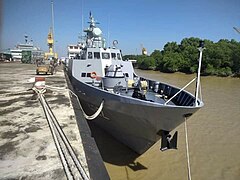Myanmar Navy
This section needs additional citations for verification. (June 2013) |
| Myanmar Navy | |
|---|---|
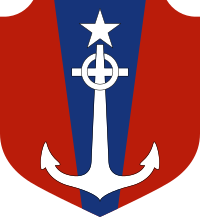 Emblem of the Myanmar Navy | |
| Founded | 24 December 1947 |
| Country | |
| Allegiance | |
| Branch | Navy |
| Size | 16,000 personnel[1] |
| Part of | |
| Headquarters | Naypyidaw |
| Colours | Navy blue, White, Black (for Myanmar Navy Seals) |
| Equipment | List of equipment in the Myanmar Navy |
| Commanders | |
| Commander-in-Chief of Myanmar Armed Forces | Senior General Min Aung Hlaing |
| Minister of Defence | General Mya Tun Oo |
| Commander-in-Chief of the Myanmar Navy | Admiral Moe Aung[2] |
| Chief of Naval Staff | Commodore Zwe Win Myint |
| Commander of the Engineering Section | Commodore Aung Thu Soe |
| Insignia | |
| Ensign |  |
| Pennant | |
| former Ensign (1948 - 1974) | 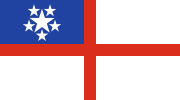 |
| former Ensign (1974 - 1994) | 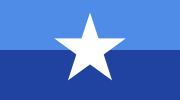 |
The Myanmar Navy (Burmese: တပ်မတော် (ရေ); [taʔmədɔ̀ jè]) is the naval warfare branch of the armed forces of Myanmar. With 24,000 personnel on duty, the navy operates more than 150 vessels. Prior to 1988, the navy was small, and its role in counter-insurgency operations was smaller than those of the army and the air force. The navy has since been expanded to take on a more active role in defense of Myanmar's territorial waters.
History
Pre-independence
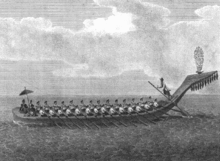
The naval arm of the Royal Armed Forces consisted mainly of shallow draft river boats. Its primary missions were to control the Irrawaddy River, and to protect the ships carrying the army to the front. The major war boats carried up to 30 musketeers and were armed with 6- or 12-pounder cannon.[3] By the mid-18th century, the navy had acquired a few seafaring ships, manned by European and foreign sailors, that were used to transport the troops in Siamese and Arakanese campaigns.
The Arakanese and the Mon, from maritime regions, maintained more seaworthy flotillas than the inland riverborne "navy" of the Royal Burmese Army.
Founding and the Second World War
Burma separated from India in 1937 and thereafter became responsible for her own local naval defence. It was decided that a naval volunteer reserve force should be formed to implement this responsibility and so provide a local force for the naval administration and defence of the ports and coast of Burma in time of war.
On the recommendation of Vice Admiral Sir James Fownes Somerville, then Commander-in-Chief, East Indies, Lieutenant Commander Kenneth Sidebottom Lyle from Royal Navy was sent to Burma and arrived in Rangoon in June 1939, commissioned to form the volunteer reserve force and to be appointed Naval Office-in-Charge, Rangoon, on the outbreak of war.
On 6 September 1940, Burma Royal Navy Volunteer Reserve was officially formed under the Burma Act XV, 1940.[4] The Burma R.N.V.R was placed under the operational orders of Vice Admiral Sir Herbert Fitzherbert, commanding the Royal Indian Navy, but retains its own identity and its own administration under the Government of Burma.
Burma R.N.V.R, although very small, played an active part in Allied operations against the Japanese during the Second World War. By 1 December 1945, the Royal Navy has been withdrawn and the Burma R.N.V.R assumed all naval responsibilities on the coast and waters of Burma.[5]
Burmese independence

In December 1947, the Union of Burma Navy was formed with 700 men mostly from Burma R.N.V.R. The fleet initially consisted of a small but diverse collection of ships transferred from the Royal Navy under the arrangements made for Burma's independence in January 1948. It included the UBS Mayu, an ex-Royal Navy River-class frigate, and four Landing Craft Gun (Medium).[6] British Defense Ministry sold with the original 25-pounder guns on naval mountings and Oerlikon 20mm cannons which were reinstalled later.
1950s
In 1950 and 1951, the United States provided 10 coast guard cutters (CGC) under the Mutual Defense Assistance Program (MDAP). The Myanmar Navy played an important part in the government's fight against the ethnic and ideological insurgent groups which threatened the Union Government in its early days. The Myanmar Navy performed both defensive and offensive roles, protecting convoys, carrying supplies, ferrying troops and giving much-needed fire support. It was instrumental in relieving the port city of Moulmein, which was captured by Karen insurgents in 1948, and the Irrawaddy Delta town of Bassein. Although one armed patrol boat defected to the Karen insurgents, throughout the turbulent years of post independence in Myanmar, the navy was largely unopposed and maintained control over Myanmar's crucial inland waterways.[7]
In 1956 and 1957, the Burmese government acquired five 50-long-ton (51 t) Saunders-Roe Dark-class convertible motor torpedo/motor gunboats,[8] followed by an 1,040-long-ton (1,060 t) Algerine-class minesweeper in 1958 from the United Kingdom.[9] In the late 1950s and early 1960s, the United States sold the Burmese Navy six PGM type coastal patrol craft and seven CGC-type patrol boats.[10] In 1958, Myanmar's Navy took delivery of 10 Y-301-class river gunboats from Yugoslavia, followed by 25 smaller Michao-class patrol craft.
1960s

Efforts were made to produce locally made naval vessels with assistance from Yugoslavia. In 1960, the Myanmar Navy commissioned two 400-long-ton (410 t) Nawarat-class corvettes. Their armaments include 25-pounder field gun and 40 mm Bofors anti-aircraft gun.[11] Myanmar shipyards also built a number of smaller patrol craft and a number of landing craft. Landing craft and auxiliary ships are usually armed with Oerlikon 20 mm cannons, 40 mm Bofors anti-aircraft guns and heavy machine guns.[12] In the mid-1960s, the Myanmar Navy took delivery of ex-US Navy 640-long-ton (650 t) PCE-827 class[13] corvette and a 650-long-ton (660 t) Admirable-class minesweeper, both of which were commissioned in the mid-1940s.
1970s
Although it expanded rapidly during the 1950s and 1960s, the navy was unable to keep pace with loss or deterioration of older vessels in the 1970s. In 1978, the United States provided the Myanmar Navy with six small river patrol craft.[14] A naval replacement program was initiated by BSPP Government in 1979.
1980s
In 1980, the navy acquired six Carpentaria-class inshore patrol boats from Australia followed by three 128-ton Swift-type coastal patrol boats from Singapore and three 385-ton Ospery-class offshore patrol vessels built in Denmark. The Osprey and Swift-class boats have a range of 4,500 and 1,800 miles (7,200 and 2,900 km), respectively, and were armed with Oerlikon 20 mm cannons and 40 mm Bofors anti-aircraft guns. In the early 1980s, Burmese naval shipyards built three 128-ton PGM type patrol boats based upon US PGM-class patrol boats. Each boat was armed with two 40 mm Bofors anti-aircraft guns and two 12.7 mm heavy machine guns.
1990s
The Myanmar Navy purchased six missile escort boats and ten submarine chasers from China. Since 1998, the navy has built two 77 m (252 ft 7 in) Anawrahta-class corvettes (771 and 772) and four fast attack craft (551-554).
2000s
2008 Naval Clash with Bangladesh
In 2008 a naval encounter took place between the Bangladesh Navy and the Myanmar Navy. The confrontation was a direct result of the Myanmar Navy allowing companies to drill for natural gas and oil in a disputed area of the Bay of Bengal. The confrontation resulted in Bangladesh's favour
May 2008 Cyclone Nargis
As many as 25 Burmese naval ships may have been sunk in the storm caused by Cyclone Nargis in May 2008, while an unknown number of naval personnel and their family members were killed or are listed as missing.[15] The Network for Democracy and Development in Thailand reported that 30 officers and 250 Burmese naval personnel were declared missing, while 25 vessels were destroyed by the cyclone in three naval regional command centres: Panmawaddy Regional Command on Hainggyi Island; Irrawaddy Regional Command; and Danyawaddy Regional Command in Sittwe in Arakan State.
2010s
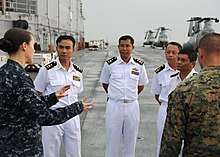
As part of international engagement of the US with the Myanmar's armed forces, the USS Bonhomme Richard (LHD-6) visited Myanmar in early 2013.[16]
In 2014, the Myanmar Navy began its annual 'Sea Shield' combined fleet exercise in the Bay of Bengal and the Andaman Sea. The annual manoeuvres usually involved live-fire exercises by several of the Myanmar Navy's strategic vessels.[17]
The navy participated in the Indian and Myanmar Navy Exercise 2018, held in the Bay of Bengal. On the Burmese side, vessels included the Kyan Sittha-class frigate UMS Sin Phyu Shin (F-14) and offshore patrol vessel UMS Inle and on the Indian side, vessels included anti-submarine warfare corvette INS Kamorta, Shivalik (Project 17)-class frigate INS Sahyadri, and a Type 877EKM Kilo-class submarine, along with one helicopter and two advanced aircraft.[18] In September 2019, Myanmar Navy's UMS Kyan Sittha participated in the first US-Asean Maritime Exercise (AUMX) to improve disaster management and maritime cooperation in the region.[19]
The navy has maintained relationships with regional navies. It has hosted navies from the region such as the Royal Australian Navy, the PLA Navy and the Indian Navy.[20][21][22] Likewise, the navy's ships have visited countries in the region including Vietnam, Thailand and Singapore.[23][24]
Commanders-in-Chief since independence
| ID | Photo | Rank | Name | Serial | Note |
|---|---|---|---|---|---|
| 1 | Commander | Khin Maung Bo | BN 4017 | BRNVR | |
| 2 | Commodore | Than Pe | BN 1001 | BRNVR | |
| 3 | Commodore | Thaung Tin | BN 1025 | ||
| 4 | Rear Admiral | Chit Hlaing | BN 3011 | BIN | |
| 5 | Rear Admiral | Maung Maung Win | BN 3021 | ||
| 6 | Vice Admiral | Maung Maung Khin | BN 1038 | ||
| 7 | Vice Admiral | Than Nyunt | |||
| 8 | Vice Admiral | Tin Aye | |||
| 9 | Vice Admiral | Nyunt Thein | BN 1087 | DSA 3 | |
| 10 | Vice Admiral | Kyi Min | BN 1107 | DSA 6 | |
| 11 | Vice Admiral | Soe Thein | BN 1181 | DSA 11 | |
| 12 | Admiral | Nyan Tun | DSA 16 | ||
| 13 | Admiral | Thura Thet Swe | BN 1282 | DSA 22 | |
| 14 | Admiral | Tin Aung San[25] | DSA 23 | ||
| 15 | Admiral | Moe Aung | BN 1374 | DSA 28[2] |


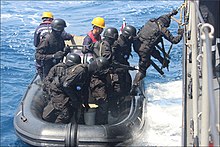
Commanders of Naval Region Command
| Naval Region Command | Commanding Officer |
|---|---|
| Irrawaddy Naval Region Command | Commodore Aye Min Htwe |
| Danyawaddy Regional Command | Commodore Kyaw Kyaw Htoo |
| Panmawaddy Regional Command | Commodore Tin Maung Than |
| Mawyawaddy Regional Command | Commodore Zaw Zaw Latt |
| Tanintharyi Regional Command | Commodore Thein Htoo |
| Naval Training Command | |
| Naval Dockyard | Rear-Admiral Dr. Zaw Win |
| 1st Fleet (Thanlyin) | Captain Kyaw Swar Htet | 1st Fleet Engineer Officer | Lt.Cdr Lwan Wai |
| 2nd Fleet (Heinze) | Captain Khin Zaw | 2nd Fleet Engineer Officer | Lt.Cdr Win Ko Latt |
| 3rd Fleet (Kyaukphyu) | Captain Ne Aung Kyaw | ||
| 4th Fleet (Haigyi Island) | Captain Nyan Linn Seinn |
Organisation
Administrative and support units
- Naval headquarters, Ministry of Defence (Naypyidaw)
- Naval Shipyard (Yangon)
- Strategic Naval Command (headquarters in Naypyidaw)
- Central Naval Command (Seikkyi)
- Naval Training Command (Seikkyi)
- Central Naval Hydrographic Depot (Yangon)
- Central Naval Diving and Salvage Depot (Yangon)
- Central Naval Engineering Depot (Botataung, Yangon)
- Central Naval Logistic Depot (Yangon)
- Central Naval Communications Depot (Yangon)
- Central Naval Armaments Deport (Seikkyi)
Naval regional commands and bases
- Irrawaddy Regional Command (headquarters in Yangon)
- Thanhklyet Soon Naval Base
- Thanlyin Naval Base
- Thanlyin Naval Base
- Thilawa Naval Base
- Coco Island Base (including Naval Radar Unit)
- Danyawaddy Regional Command (headquarters in Sittwe)
- Panmawaddy Regional Command (headquarters on Haigyi Island)
- Mawyawaddy Regional Command (headquarters in Mawlamyine)
- Tanintharyi Regional Command (headquarters in Myeik)
- Zadetkyi Island Naval Base
- Mali (Tavoy) Naval Base
- Palai Island Naval Base
- Kadan Naval Base
- Sakanthit Naval Base
- Lambi Naval Base
- Pearl Island Naval Base
- Zadetkale Naval Base (Radar Unit)
Naval infantry
The Myanmar Navy formed a naval infantry battalion of 800 men in 1964, and a second battalion in 1967.[citation needed] They battalions traditionally are deployed mainly in the Arakan, Tenasserim, and Irrawaddy delta coastal regions primarily to assist in the army's counter-insurgency operations (COIN).[citation needed]
Navy SEALs
The Myanmar Navy Sea, Air and Land (SEAL) Teams, commonly known as Myanmar Navy SEALs (တပ်မတော် (ရေ) အထူးစစ်ဆင်ရေးတပ်ဖွဲ့) were probably formed in the early 2010s. The Myanmar Navy SEALs are particularly trained for special operation missions such as Hostage rescue, Counter-terrorism and Counter narcotic operations. The selection process and training curriculum is claimed be similar to United States Navy SEAL selection and training.[26][27][28]
Naval base air defence force
Previously, Myanmar Naval air defence forces used Bofors 40mm & ZPU-2 AAA for naval bases.
Rank structure
Commissioned officer ranks
The rank insignia of commissioned officers.
| Rank group | General / flag officers | Senior officers | Junior officers | |||||||||||||||||||||
|---|---|---|---|---|---|---|---|---|---|---|---|---|---|---|---|---|---|---|---|---|---|---|---|---|

|

|

|

|

|

|

|

|

|

|

|

| |||||||||||||
| ဗိုလ်ချုပ်မှူးကြီး bogyok hmūgyī |
ဒုတိယ ဗိုလ်ချုပ်မှူးကြီး dụtịyạ bogyok hmūgyī |
ဗိုလ်ချုပ်ကြီး bogyok kyī |
ဒုတိယ ဗိုလ်ချုပ်ကြီး dụtịyạ bogyok kyī |
ဗိုလ်ချုပ် bogyok |
ဗိုလ်မှူးချုပ် bohmūgyok |
ဗိုလ်မှူးကြီး bohmūgyī |
ဒုတိယ ဗိုလ်မှူးကြီး dụtịyạ bohmūgyī |
ဗိုလ်မှူး bohmū |
ဗိုလ်ကြီး bogyī |
ဗိုလ် bo |
ဒုတိယ ဗိုလ် dụtịyạ bo | |||||||||||||
Other ranks
The rank insignia of non-commissioned officers and enlisted personnel.
| Rank group | Senior NCOs | Junior NCOs | Enlisted | |||||||||||||||||||||||||||||||||
|---|---|---|---|---|---|---|---|---|---|---|---|---|---|---|---|---|---|---|---|---|---|---|---|---|---|---|---|---|---|---|---|---|---|---|---|---|

|

|
No insignia | No insignia | |||||||||||||||||||||||||||||||||
| အရာခံဗိုလ် ’araākhaṃ bauilaʻ |
ဒုတိယအရာခံဗိုလ် dautaiya ’araākhaṃ bauilaʻ |
အုပ်ခွဲတပ်ကြပ်ကြီး aupaʻ khavai tapaʻ karpaʻ karīʺ |
တပ်ကြပ်ကြီး tapaʻ karpaʻ karīʺ |
တပ်ကြပ် tapaʻ karpaʻ |
ဒုတိယတပ်ကြပ် dautaiya tapaʻ karpaʻ |
တပ်သား tapaʻ saāʺ |
တပ်သားသစ် tapaʻ saāʺ sacaʻ | |||||||||||||||||||||||||||||
Equipment
Modernisation
The Myanmar Navy has undertaken a modernisation program since the early 2000s. It has added larger and more advanced ships, mostly by constructing them locally with foreign supplied equipment.[29]
Frigates

The Myanmar Navy started its modernization program in 2001 in an attempt to replace older ships and equipment. In 2012, the navy took delivery of two Type 053H1-class frigates from China. These two ships were upgraded extensively. Upgrades included the replacing of HY 2 anti-ship missiles by C-802 missiles and installing new sensors. The first indigenous frigate, the Aung Zeya entered service in 2011 and took part in a joint exercise with Indian Navy ships off Visakhapatnam in early 2013. A second ship, Kyan Sittha entered service in 2012 and is the navy's first stealth frigate. The navy plans to build six indigenous frigates; combining Russian, Indian, Chinese, and Western weapons systems. These ships are equipped with Kh-35E anti-ship missiles, OTO Melara 76 mm Super Rapid Cannons, AK-630 6-barrel 30mm close-in weapon system (CIWS) and Chinese ASW rockets and torpedoes. Radars and electronic systems are mainly from Bharat Electronics of India. Myanmar acquired surface-to-air missiles and anti-ship missiles from China for its newly built frigates and OPVs. Myanmar Navy Shipyard built with Chinese assistance in the late 1990s is one of the most modern shipyards in the region. Many Burmese naval engineers underwent shipbuilding training in China and Russia.
Submarines
In 2020, the navy acquired its first submarine, a Soviet era Sindhughosh/Kilo-class submarine, from India. The former INS Sindhuvir (S58) was refitted by Hindustan Shipyard Limited before the handover. Now renamed UMS Minye Theinkhathu, the submarine is to be used for training.[30][31] It was first seen publicly on 15 October 2020 as part of a naval fleet exercise (‘Bandoola 2020’).[32] The Indian Navy is going to assist in training Myanmar to operate the submarine effectively.[33]
Others
Between 2015 and 2017, the Myanmar Navy procured two Super Dvora Mk III patrol boats from Israel.[34] Next, under a US$37.9 million deal signed in March 2017, the Myanmar Navy received the advanced anti-submarine torpedo Shyena units from India.[35] Moreover, the Myanmar Navy acquired a new landing platform dock (LPD) from South Korea in 2019.[36]
Gallery
-
UMS Minye Theinkhathu of Myanmar Navy
-
FAC(M) 491 of Myanmar Navy
-
FAC(M) 492 of Myanmar Navy
-
UMS Duwan, one of the ships of the Houxin IG-class of missile boats
-
FAC(Gun) 565 of Myanmar Navy
-
UMS Yan Aye Aung, one of the ships of Hainan-class submarine chaser
-
Torpedo boat, T-201
-
PGM-416
-
PGM-413
-
PGM-403
See also
References
- ^ International Institute for Strategic Studies (February 2021). The Military Balance 2021. Routledge. pp. 285–287. ISBN 978-1032012278.
- ^ a b "ဒုတိယ ဗိုလ်ချုပ်ကြီး မောင်မောင်အေး ကြည်း၊ ရေ၊ လေ ညှိနှိုင်းကွပ်ကဲရေးမှူး ဖြစ်လာ". 4 February 2021.
- ^ Lieberman, pp. 164–167
- ^ "Naval Forces of the Colonies 1461. BURMA ROYAL NAVAL VOLUNTEER RESERVE".
- ^ "Burma the Military" (PDF).
- ^ p.28, Janes Fighting Ships 1963-64
- ^ Hugh Tinker, Union of Burma, p.325
- ^ "British Military Powerboat Trust". Archived from the original on 23 September 2015. Retrieved 22 October 2014.
- ^ Jane's Fighting Ships 1963-1964 p.28
- ^ Jane's Fighting Ships 1982-83 p.60
- ^ Janes Fighting Ships 1997-98 p.79
- ^ Janes Fighting Ships 1997-98 p.82
- ^ "Archived copy". Archived from the original on 1 May 2011. Retrieved 19 February 2007.
{{cite web}}: CS1 maint: archived copy as title (link) - ^ Jane's Fighting Ships 1997-1998 p.79
- ^ "Burmese Navy Decimated in Cyclone". Archived from the original on 13 May 2008. Retrieved 13 May 2008.
- ^ "The evolving role of the Navy". Archived from the original on 26 December 2018.
- ^ "Myanmar Navy holds exercise in strategic waters". Archived from the original on 25 December 2018.
- ^ "What's Behind the New India-Myanmar Naval Exercise?". Archived from the original on 26 December 2018.
- ^ Limited, Bangkok Post Public Company. "First US-Asean naval exercise begins". www.bangkokpost.com. Retrieved 17 September 2019.
{{cite web}}:|last=has generic name (help) - ^ Navy, Royal Australian. "Patrol Boat crew reflects on a memorable visit to Myanmar". Navy Daily. Retrieved 2 October 2019.
- ^ "Vietnamese vessel visits Myanmar".
- ^ "Indian Naval Ship Sumitra visited Yangon, Myanmar | Indian Navy". www.indiannavy.nic.in. Retrieved 2 October 2019.
- ^ "Burmese Navy in Historic Visit to Vietnam". www2.irrawaddy.com. Retrieved 2 October 2019.
- ^ "Myanmar navy ships return to Thailand". Bangkok Post. 2013.
- ^ "45 Senior Military Officers Retire to Contest Nov. 8 Poll". The Irrawaddy. 11 August 2015. Archived from the original on 15 August 2015. Retrieved 15 August 2015.
- ^ "တပ်မတော် (ကြည်း၊ ရေ၊ လေ) ပူးပေါင်းစစ်ဆင်ရေးလေ့ကျင့်ခန်း (ဆင်ဖြူရှင်) ဒုတိယပိုင်း လေ့ကျင့်ဆောင်ရွက်" [Army (Army, Navy, Air) Joint Exercise Exercise (White Elephant) Second Exercise] (in Burmese).
- ^ Myanmar Navy Documentary, archived from the original on 14 December 2021, retrieved 12 October 2019
- ^ "Myanmar navy conducts military exercise in Bay of Bengal - Xinhua | English.news.cn". www.xinhuanet.com. Archived from the original on 30 March 2019. Retrieved 12 October 2019.
- ^ "Modernization of the Myanmar Navy". Archived from the original on 29 December 2018.
- ^ Pubby, Manu (30 July 2019). "Taking it to next level, India readies submarine for Myanmar". The Economic Times. Retrieved 6 October 2019.
- ^ "Kilo Impact in the Bay of Bengal". thediplomat.com. Retrieved 2 October 2019.
- ^ "Myanmar Navy showcases newly acquired submarine in Fleet Exercise Bandoola". janes.com. Retrieved 19 October 2020.
- ^ Gaurav Sawant (17 October 2020). "Myanmar Navy to acquire its first submarine, INS' retrofitted Sindhuvir". India Today.
- ^ "Report: Myanmar Acquired Super Dvora Mk 3 Boats from IAI | Israel Defense". www.israeldefense.co.il. Retrieved 2 October 2019.
- ^ "The five-domains update". The Strategist. 23 July 2019. Retrieved 11 October 2019.
- ^ "South Korean shipyard launches landing platform dock for Myanmar Navy | Jane's 360". www.janes.com. Retrieved 2 October 2019.
Further reading
- Jha, Saurav (30 December 2016). "The Bay of Bengal Naval Arms Race". The Diplomat. Retrieved 8 March 2021.)
External links
- The Naval Institute Guide to Combat Fleets of the World: Their Ships By Eric Wertheim
- pageMyanmar Navy.html - complaints, reviews & rating


